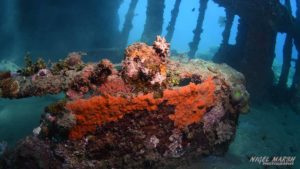We don’t call it Iron Bottom Sound for nothing, with 100s of wrecks off the coast of Guadalcanal in the Solomon Islands. But although many of them are deep, the wrecks of Iron Bottom Sound are not just in the realm of tech divers. Some are just a few feet off the beach, easy shore dives that include B7 bombers, Japanese transports and an enormous submarine.
When World War II came to the Solomon Islands in 1942, it left an indelible stain on the island nation. Some of the bloodiest battles of the conflict occurred on the land, air and sea around Guadalcanal, particularly in the area that is now downtown Honiara. Today the capital of the Solomon Islands is a busy port town, but you don’t have to look far to find evidence of the war here, especially when you plunge beneath the waves.
The battle for Guadalcanal lasted more than six months, but it was the turning point of the war in the Pacific. It was the first major defeat for the Japanese, forcing them on the defensive and giving the Allied forces momentum for their eventual victory. But the victory came at a heavy cost in Guadalcanal, with the loss of ships, planes and many lives.
Battle sites, museums and war memorials to the fallen troops are scattered around Honiara, but divers can visit more tangible links to the war, exploring the many shipwrecks that rest in the waters nearby.
With many of the best shipwrecks off Honiara accessible from the shore, the local dive shop, Tulagi Dive, can ferry you there by road. Here are our picks for a few of the best.
Bonegi 1
The 508-foot-long (155 m) Japanese military transport ship Hirokawa Maru ran aground in 1942 after being mortally wounded. The ship now rests on its port side in depths from 10 to 164 feet (3 to 50 m).
Covered in beautiful soft corals, sponges and gorgonians, this ship is a wonderful artificial reef. On your first dive here, you may get to 130 feet (40 m), checking out the holds, kingposts and other features in the 65-foot (20 m) visibility. It will take several dives to really see all the features of this large shipwreck, so plan your second and third for shallower depths.
Bonegi 2

The nearby Japanese military transport ship, the Kinugawa Maru, also ran aground in 1942. It was originally 436 feet (133 m) long, but its bow section is completely obliterated. The ship now rests in 6.5 to 85 feet (2 to 26 m) and is a great dive. This wreck is also covered in pretty corals and has a lot more fish life, including schools of snapper, drummer and fusiliers. Tour the holds and stern section and encounter batfish, sweetlips and maybe even a few mobula rays.
Japanese I-1 submarine
Sunk by two New Zealand navy ships in 1943 and later blown apart by salvage divers, this 321-foot-long (98 m) submarine now rests in 33 to 98 feet (10 to 30 m).
Although in pieces, this sub is a wonderful dive with plenty to see. Divers can penetrate part of the hull, allowing them to see the engines and air tanks. The stern section is the most intact, but the props are missing. Many reef fish and invertebrate species now call the sub home, and corals decorate the hull.
Boeing B-17E bomber
This Boeing B-17E bomber, also called the ‘Flying Fortress,’ crash-landed in 1942. This impressive plane wreck rests on a sandy slope in depths from 33 to 62 feet (10 to 19 m). Although it is missing its tail and the nose is badly broken, it is a fascinating dive. On show are the four engines, the giant wings, cockpit and a gun turret. The plane is also home to numerous fish, including schools of snapper, baitfish and fusiliers. Sadly, none of the nine crew survived the crash.
Other wrecks off Honiara include the Japanese transport ship Kyusya Maru, which you can also dive from shore. Accessible by boat are the Japanese freighter Azumason Maru, the U.S. Coast Guard liberty ship USS Serpens and the U.S. attack transport ship USS John Penn. When you add the ship- and plane-wrecks off nearby Tulagi, it becomes clear that Guadalcanal is one of the best wreck-diving destinations in the world — for both techies and recreational divers.





